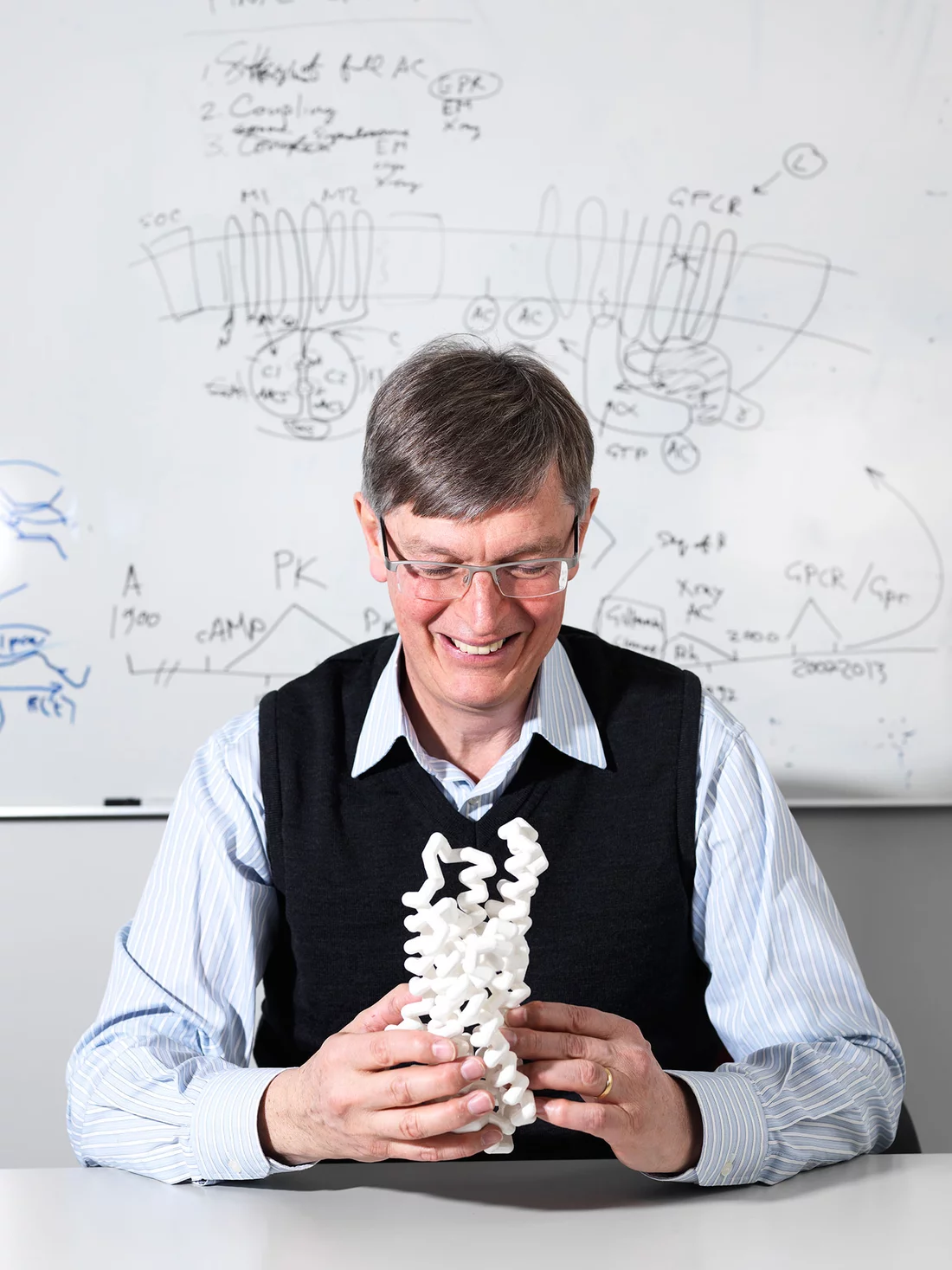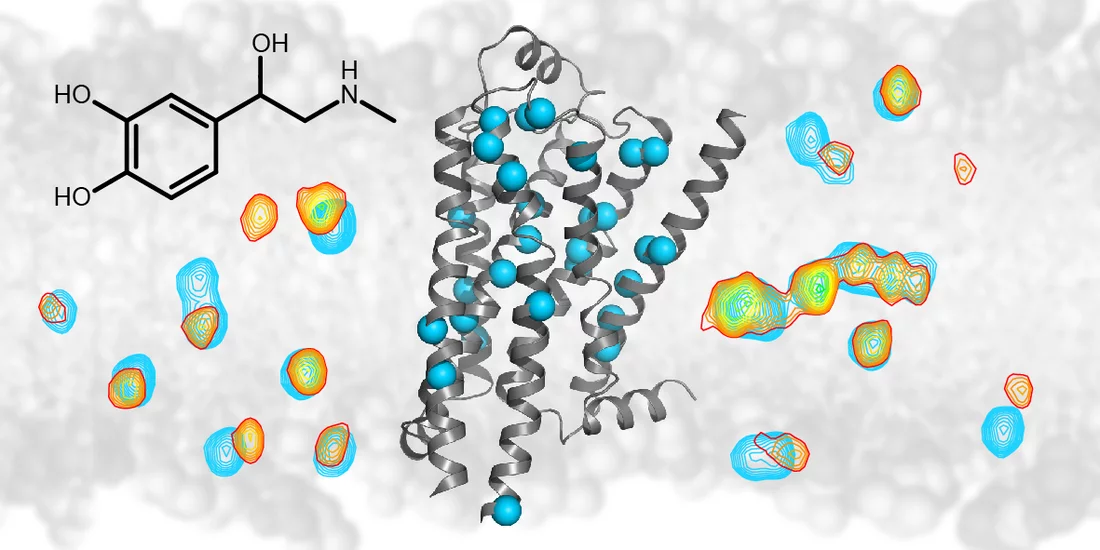New insights into the workings of important drug receptors
In order to accomplish their healing effects, medical drugs don't necessarily have to work their way inside the cells of our body. Many medicines operate instead on specific receptors in the cells' outer walls. These receptors reach into the interior of the cells, where they can set in motion a desired reaction. One of these is called the beta-1 adrenergic receptor. Among other things, it is responsible for palpitation, the racing pulse, that we feel when we're experiencing stage fright – or when we're falling in love. Studying the beta-1 adrenergic receptor as a representative example, researchers at the Paul Scherrer Institute PSI have, together with colleagues at the Biozentrum of the University of Basel, revealed in detail how this signal transmission to the cellular interior functions. Their findings can be applied to a whole class of similar cellular receptors and thus help scientists better understand many drugs' mode of action. As a consequence, this method could one day contribute to the development of improved pharmaceuticals. This new study was published in the journal Nature.
The doorbell has barely been touched, yet it has already set things moving in the house – without the visitor having to set foot inside. Quite similar is the action of many medicines, including beta-blockers against high blood pressure and drugs for the treatment of allergies, cancer, Parkinson's disease and HIV. These active agents bind to receptors that sit in the outer walls of the body's cells. Just like the doorbell, the receptors send a signal into the cellular interior, which in turn leads to the desired effect.
Probing the heartbeat receptor
One of these doorbells, the beta-1 adrenergic receptor, has now been closely examined by a collaborative team of researchers at the the Biozentrum of the University of Basel and the Paul Scherrer Institute PSI. By means of nuclear magnetic resonance (NMR) spectroscopy, the scientists were able to trace how the structure of these receptors responds to different agents – that is, how a receptor changes its structure and, in doing so, transmits a specific signal to the cellular interior.
The beta-1 adrenergic receptor is found, among other places, in the outer walls of heart cells. It is activated, for example, by the hormone noradrenaline, triggering a signaling cascade that ultimately results in increased heart rate and blood pressure. Thus the beta-1 adrenergic receptor is responsible for the racing pulse that comes with stage fright or infatuation.
Beta-blockers counteract the hormone by preventing it from docking to the beta-1 adrenergic receptor. The researchers have now brought to light precise details about how the binding of various molecules with the beta-1 adrenergic receptor changes its structure and thus influences its signal transmission.
Results can be applied to other important drug receptors
The beta-1 adrenergic receptor belongs to the family of receptors known as G protein coupled receptors. Because these all have comparable mechanism of action, the researchers' new results can be applied to the entire receptor family. G protein coupled receptors, in turn, are responsible for the mode of action of roughly 30 percent of all newly approved drugs and are, therefore, of great medical importance.
Only the combined expertise of the researchers at the Paul Scherrer Institute and the Biozentrum Basel made this result possible,
agree Dmitry Veprintsev and Gebhard Schertler of the PSI. Their teams have years of experience in research with G protein coupled receptors. They drew on this to develop a stabilized version of the beta-1 adrenergic receptor, a prerequisite for the high quality of the NMR measurements made at the Biozentrum Basel.
We have applied high resolution NMR to analyze the structural changes of the beta-1 adrenergic receptor upon binding of various drugs,
explains first author Shin Isogai. We could observe how the receptor recognizes the binding partner, interprets its chemical structure and transmits this information to the inside of the cell by changing its structure.
NMR method could be applied to the development of new drugs
Using NMR the researchers were able to trace how the receptor changed its structure. Thus they were able to determine how deep inside the receptor an active agent penetrated, how it pushed aside individual protein sections in the process and how this mechanical signal was transferred into the interior of the cell. The NMR data also gave a direct measurement for the binding strength of the various agents and for their potential to trigger a response in the cell. The researchers were even able to trace one such response directly, which sprang from the binding of an intracellular signaling protein with the activated receptor.
We are very happy that we could see these details. The receptors are notoriously difficult to study. Many researchers have tried for more than a decade,
emphasizes Isogai. Now we can apply this method to see the function of individual amino acids and to study other receptors.
In the future, the NMR method may also be used for drug screening and drug development.
Text: Paul Scherrer Institute/Laura Hennemann;
Text based on a press release published by the University of Basel
About PSI
The Paul Scherrer Institute PSI develops, builds and operates large, complex research facilities and makes them available to the national and international research community. The institute's own key research priorities are in the fields of matter and materials, energy and environment and human health. PSI is committed to the training of future generations. Therefore about one quarter of our staff are post-docs, post-graduates or apprentices. Altogether PSI employs 1900 people, thus being the largest research institute in Switzerland. The annual budget amounts to approximately CHF 380 million.
(Last updated in April 2015)
Contact
Dr. Dmitry Veprintsev, Head of Project, Laboratory for Biomolecular Research,Paul Scherrer Institute
Telephone: +41 56 310 52 46, e-mail: dmitry.veprintsev@psi.ch [English]
Dr. Gregor Cicchetti, Scientific Relations Manager, Division for Biology und Chemistry,
Paul Scherrer Institute
Telephone: +41 56 310 53 82, e-mail: gregor.cicchetti@psi.ch [German, English]
Prof. Gebhard Schertler, Head of Division, Division for Biology and Chemistry at Paul Scherrer Institute,
Professor for Structural Biology at ETH Zürich,
Telephone: +41 56 310 42 65, e-mail: gebhard.schertler@psi.ch [German, English]
Original Publication
Backbone NMR reveals allosteric signal transduction networks in the β1-adrenergic receptorS. Isogai, X. Deupi, C. Opitz, F.M. Heydenreich, F. Brueckner, G.F.X. Schertler,
D.B. Veprintsev and S. Grzesiek
Nature 3. Februar 2016 (online)
DOI: 10.1038/nature16577



